Global Culinary Journeys: From Peru to Scandinavia
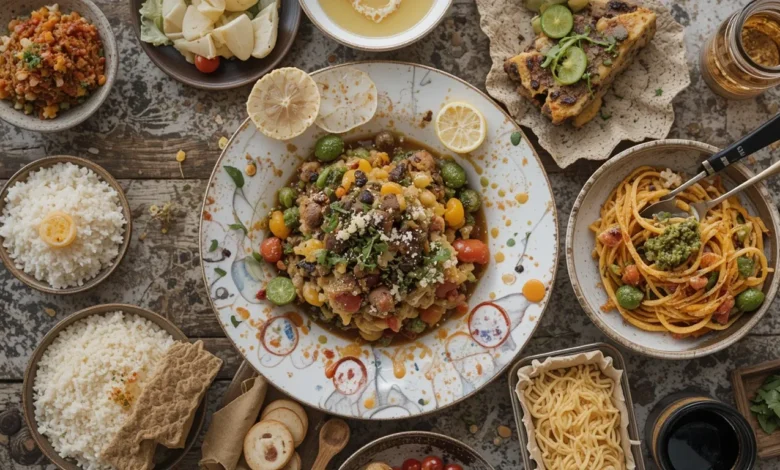
Global Culinary Journeys: From Peru to Scandinavia
Embark on a world tour of exceptional food experiences that connect travelers with authentic cultural traditions. This comprehensive guide explores diverse culinary landscapes from Peru’s ancient ingredients to Norway’s sustainable seafood, Spain’s regional specialties, Bangkok’s fine dining revolution, and Scandinavia’s distinctive food philosophy.
Whether you’re planning your next international adventure or simply dreaming of global flavors, this guide will transport your taste buds across continents.
Peru Food & Culture Guide: Ancient Traditions Meet Modern Gastronomy
Peru has emerged as South America’s gastronomic powerhouse, blending indigenous ingredients with influences from Spanish, African, Chinese, and Japanese cuisines. This unique fusion has created one of the world’s most exciting culinary destinations.
Essential Peruvian Dishes Every Traveler Must Try
Peruvian cuisine features incredible diversity, with each region offering distinctive specialties that reflect local geography and cultural history.
Coastal Classics:
- Ceviche: Peru’s national dish featuring raw fish “cooked” in citrus juice with onions, chili, and cilantro
- Tiradito: A Japanese-influenced dish similar to sashimi with a spicy citrus sauce
- Causa: Cold potato terrine layered with avocado and seafood
Andean Treasures:
- Pachamanca: Ancient technique of cooking meat and vegetables underground with hot stones
- Cuy: Guinea pig traditionally roasted whole, a pre-Columbian delicacy
- Quinoa soup: Hearty highland soup with the “mother grain” of the Incas
Amazonian Specialties:
- Juane: Rice and chicken wrapped in bijao leaves
- Tacacho con cecina: Plantain fritters with dried meat
- Paiche: Amazon’s largest freshwater fish prepared in various ways
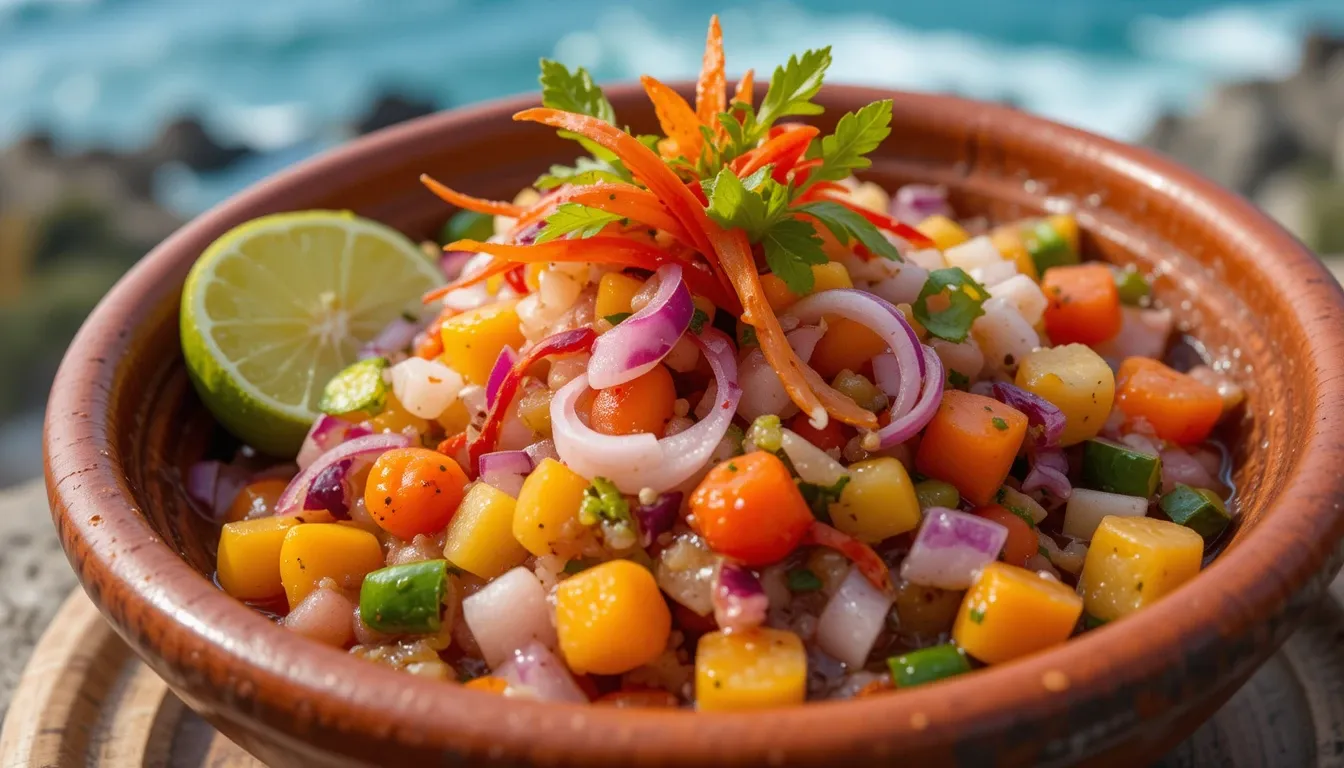
“Traditional Peruvian ceviche featuring fresh fish ‘cooked’ in lime juice with red onions, sweet potato, and Peruvian corn”
Cultural Significance of Food in Peruvian Identity
Food in Peru transcends mere sustenance it represents national pride and cultural heritage preserved through generations.
Inca Agricultural Legacy: Peru’s food culture builds on remarkable Inca innovations including:
- Cultivation of over 4,000 potato varieties
- Development of freeze-drying techniques (chuño)
- Sophisticated irrigation systems still in use today
- Terrace farming on steep Andean slopes
Community and Celebration: Traditional food preparation in Peru remains communal, with many dishes connecting directly to important ceremonies:
- Pachamanca honors Pachamama (Mother Earth)
- Feast of Santa Rosa features special sweets and desserts
- Carnival celebrations include unique regional specialties
For a deeper exploration of Peru’s extraordinary connection between food and ritual, check out our Peruvian Festival Guide.
Lima’s World-Class Restaurant Scene
Peru’s capital has transformed into a global culinary destination with multiple restaurants ranking among the world’s best.
Award-Winning Establishments:
- Central: Chef Virgilio Martínez’s exploration of Peru’s ecosystems from sea level to high Andes
- Maido: Nikkei cuisine (Japanese-Peruvian fusion) from Chef Mitsuharu Tsumura
- Astrid y Gastón: Chef Gastón Acurio’s flagship restaurant celebrating Peruvian classics with modern techniques
Accessible Culinary Experiences:
- Food markets like Mercado Surquillo No. 1
- Cooking classes featuring traditional techniques
- Street food tours highlighting local specialties
For budget-conscious travelers seeking authentic flavors, visit our guide to Lima’s Best Budget Eats.
Culinary Travel Experiences Beyond Lima
While Lima dominates Peru’s fine dining scene, culinary adventures await throughout the country.
Arequipa: Peru’s Culinary Hidden Gem
- Picanterías: Traditional family-run restaurants serving regional specialties
- Rocoto relleno: Stuffed spicy peppers unique to the region
- Chupe de camarones: Rich prawn chowder with local ingredients
Sacred Valley Culinary Traditions
- Earth ovens (huatias): Traditional cooking using hot stones and earth
- Chicha production: Fermented corn beer with ancient origins
- Agricultural tours: Visit farms growing native potatoes and corn varieties
Culinary Learning Opportunities
- Hands-on pachamanca preparation
- Traditional fermentation workshops
- Cacao and coffee experiences in the jungle regions
Norway Sustainable Travel Guide: Eco-Conscious Exploration of Fjords and Flavors
Norway offers a perfect blend of breathtaking landscapes and pioneering sustainable practices. This section explores how to experience Norway’s natural and culinary wonders while minimizing your environmental impact.
Norway’s Farm-to-Table Philosophy
Norwegian cuisine emphasizes hyperlocal ingredients and traditional preservation methods, creating a natural foundation for sustainable dining.
Seasonal Norwegian Ingredients:
- Summer: Wild berries, new potatoes, and fresh seafood
- Fall: Game meats, mushrooms, and apples
- Winter: Preserved fish, root vegetables, and hearty stews
- Spring: Foraged greens, lamb, and the first seafood harvest
Specialty Products with Protected Origin Status:
- Fenalår fra Norge: Traditional cured leg of lamb
- Tørrfisk fra Lofoten: Air-dried Arctic cod from Lofoten Islands
- Hardangereple: Apples from the Hardanger region
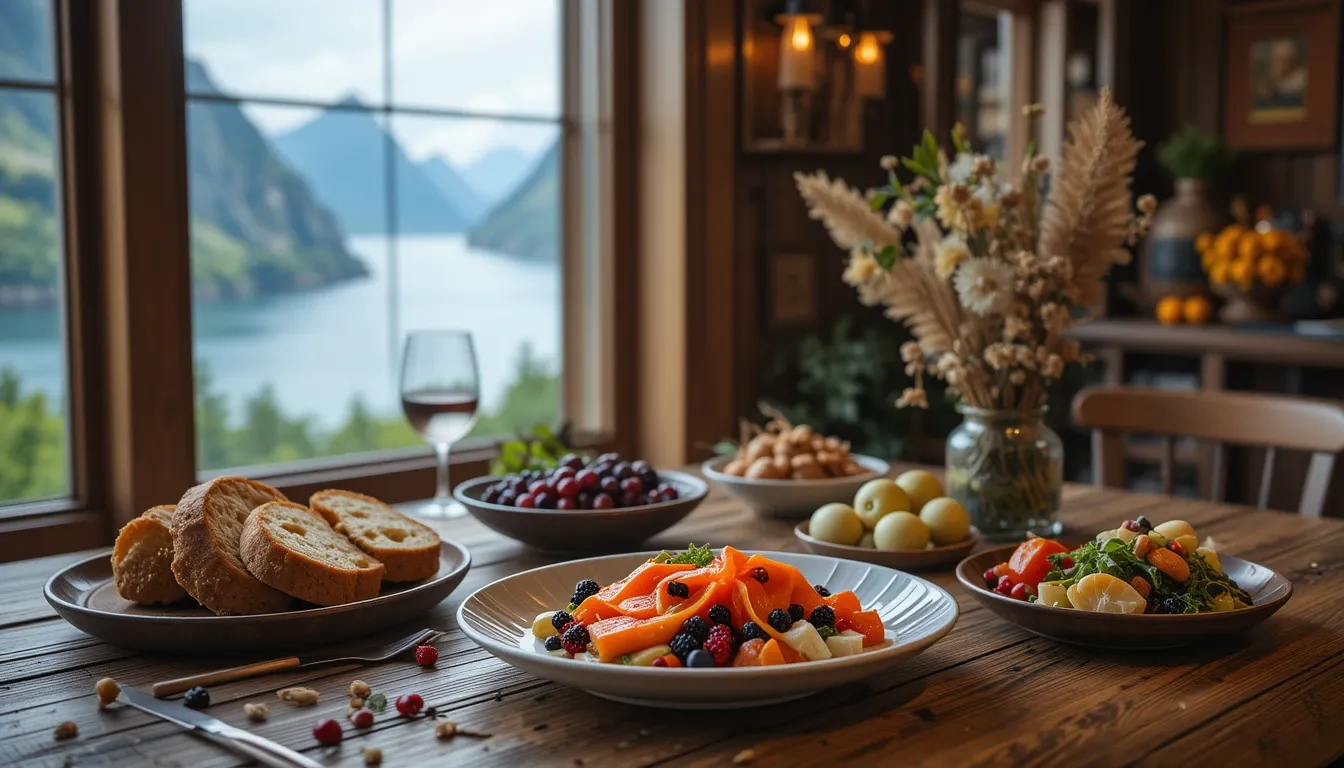
“Sustainable Norwegian farm-to-table meal featuring locally sourced ingredients with a scenic fjord view”
Eco-Friendly Accommodation Options
Norway offers numerous lodging options that combine comfort with environmental responsibility.
Forest Retreats:
- Juvet Landscape Hotel: Award-winning minimalist design with minimal environmental impact
- TreeTop Fiddan: Sustainable treehouses powered by renewable energy
- Birdboxes: Innovative glass-fronted cabins designed to blend with nature
Urban Eco-Hotels:
- Comfort Hotel Børsparken (Oslo): First energy-positive hotel in Norway
- Scandic Nidelven (Trondheim): Award-winning breakfast featuring local organic producers
- Bergen Børs Hotel: Renovated historic building with comprehensive sustainability program
Working Farm Stays:
- Experience traditional Norwegian farming practices
- Participate in seasonal harvesting activities
- Learn traditional food preservation techniques
Discover more sustainable accommodation options in our detailed Eco-Friendly Norway Lodging Guide.
Low-Impact Transportation Through Norway’s Landscapes
Explore Norway’s stunning scenery while minimizing your carbon footprint with these transportation options.
Electric Vehicle Infrastructure:
- Norway leads the world in EV adoption with extensive charging networks
- Electric car rentals available at major airports and cities
- Zero-emission zones in urban centers
Scenic Train Journeys:
- Bergen Railway: One of Europe’s most beautiful train routes
- Flåm Railway: Steep mountain railway with breathtaking views
- Nordland Line: Arctic Circle crossing with spectacular scenery
Water-Based Exploration:
- Electric ferry services in the fjords
- Sailing tours using traditional Norwegian vessels
- Kayaking expeditions for intimate fjord experiences
The Norwegian Trekking Association maintains an extensive network of hiking trails and cabins for sustainable wilderness experiences.
Sustainable Seafood Experiences
Norway’s relationship with the sea defines both its culture and cuisine, with sustainability practices that protect marine resources.
Responsible Fishing Tours:
- Join small-scale fishermen using traditional methods
- Learn about Norway’s strict fishing regulations
- Prepare your catch using local recipes
Pioneering Aquaculture:
- Visit innovative salmon farms implementing closed-containment systems
- Learn about feed sustainability improvements
- Understand certification standards ensuring environmental protection
Seafood Markets and Dining:
- Bergen Fish Market: Historic marketplace with sustainable options
- Seafood restaurants with MSC certification
- Traditional preservation methods: Smoking, drying, and fermentation
Spain Culinary Road Trip Itinerary: A Gastronomic Journey Through Regions
Spain’s diverse culinary landscape makes it perfect for food-focused road trips that connect distinct regional cuisines, revealing the country’s rich cultural heritage through its plates.
Northern Spain: Basque Country to Galicia
Begin your Spanish culinary journey in the gastronomically rich north, home to some of the world’s most celebrated food regions.
San Sebastián: Pintxos Paradise (Days 1-2)
- Essential Experience: Bar-hopping along Calle 31 de Agosto for traditional pintxos
- Must-Try Dishes: Gilda (olive, anchovy, and pepper skewer), tortilla de bacalao
- Restaurant Recommendation: Asador Etxebarri for wood-fired perfection
- Local Winery Visit: Txakoli producers in nearby Getaria
Rioja Wine Region (Days 3-4)
- Essential Experience: Underground winery tours in medieval villages
- Must-Try Dishes: Lechazo asado (roast lamb), patatas a la riojana
- Restaurant Recommendation: Echaurren for traditional Riojan cuisine
- Cultural Stop: Vivanco Museum of Wine Culture

“Traditional pintxos displayed on a bar counter in San Sebastián, showcasing the Basque Country’s renowned culinary specialties”
Galicia: Seafood Heaven (Days 5-7)
- Essential Experience: Visit a traditional seafood market in Vigo
- Must-Try Dishes: Pulpo a la gallega (octopus), percebes (goose barnacles)
- Restaurant Recommendation: D’Berto for the ultimate seafood feast
- Cultural Stop: Witness the Albariño wine harvest (seasonal)
For detailed recommendations on Basque Country restaurants, see our San Sebastián Dining Guide.
Central Spain: Madrid to Extremadura
Continue through Spain’s heartland, where hearty meat dishes and surprising flavors await.
Madrid Culinary Classics (Days 8-9)
- Essential Experience: Mercado San Miguel food market exploration
- Must-Try Dishes: Cocido madrileño, calamares a la romana
- Restaurant Recommendation: Casa Lucio for traditional Madrid cuisine
- Cultural Stop: Early morning chocolate con churros at Chocolatería San Ginés
Toledo: Medieval Flavors (Day 10)
- Essential Experience: Marzipan workshop with artisan producers
- Must-Try Dishes: Carcamusas (pork stew), perdiz estofada (partridge stew)
- Restaurant Recommendation: Adolfo for traditional Castilian cuisine
- Cultural Stop: Saffron producers in nearby La Mancha
Extremadura: Spain’s Hidden Culinary Gem (Days 11-12)
- Essential Experience: Iberian ham tour in Montánchez
- Must-Try Dishes: Migas extremeñas, torta del casar (sheep cheese)
- Restaurant Recommendation: El Figón de Eustaquio in Cáceres
- Cultural Stop: Pimentón (paprika) production in La Vera
Mediterranean Spain: Catalonia to Andalusia
Complete your journey along Spain’s stunning Mediterranean coast, where seafood, rice dishes, and Moorish influences create distinctive cuisines.
Barcelona: Catalan Creativity (Days 13-14)
- Essential Experience: La Boqueria market tour with cooking class
- Must-Try Dishes: Fideuà, calçots (seasonal), bombas
- Restaurant Recommendation: Disfrutar for modern Catalan cuisine
- Cultural Stop: Cava producers in Penedès wine region
Valencia: Birthplace of Paella (Days 15-16)
- Essential Experience: Authentic paella cooking workshop
- Must-Try Dishes: Paella valenciana, horchata with fartons
- Restaurant Recommendation: Casa Carmela for traditional wood-fired paella
- Cultural Stop: Visit the Central Market and Albufera rice fields
Andalusia: Moorish Influences (Days 17-21)
- Essential Experience: Olive oil tasting in Jaén province
- Must-Try Dishes: Salmorejo, rabo de toro, pescaíto frito
- Restaurant Recommendation: El Churrasco in Córdoba
- Cultural Stop: Sherry bodega tours in Jerez
For vegetarian and plant-based options throughout this route, see our guide to Plant-Based Dining in Spain.
Bangkok Fine Dining Guide: Elevated Thai Cuisine and International Excellence
Bangkok has transformed into one of Asia’s premier fine dining destinations, where traditional Thai cuisine meets global culinary innovation in spectacular settings.
Bangkok’s Michelin-Starred Thai Restaurants
Experience Thailand’s complex flavors elevated to fine dining perfection at these acclaimed establishments.
Le Du
- Concept: Contemporary Thai cuisine using 100% local ingredients
- Signature Dish: Khao kluk kappi (river prawn with shrimp paste rice)
- Chef Profile: Thitid “Ton” Tassanakajohn brings French techniques to Thai flavors
- Price Range: ฿฿฿฿ (3,000+ baht tasting menu)
R-Haan
- Concept: Royal Thai cuisine with seasonal focus
- Signature Dish: Tom yum with river prawn and coconut milk
- Chef Profile: Chef Chumpol elevates traditional recipes from ancient cookbooks
- Price Range: ฿฿฿฿ (2,900+ baht tasting menu)
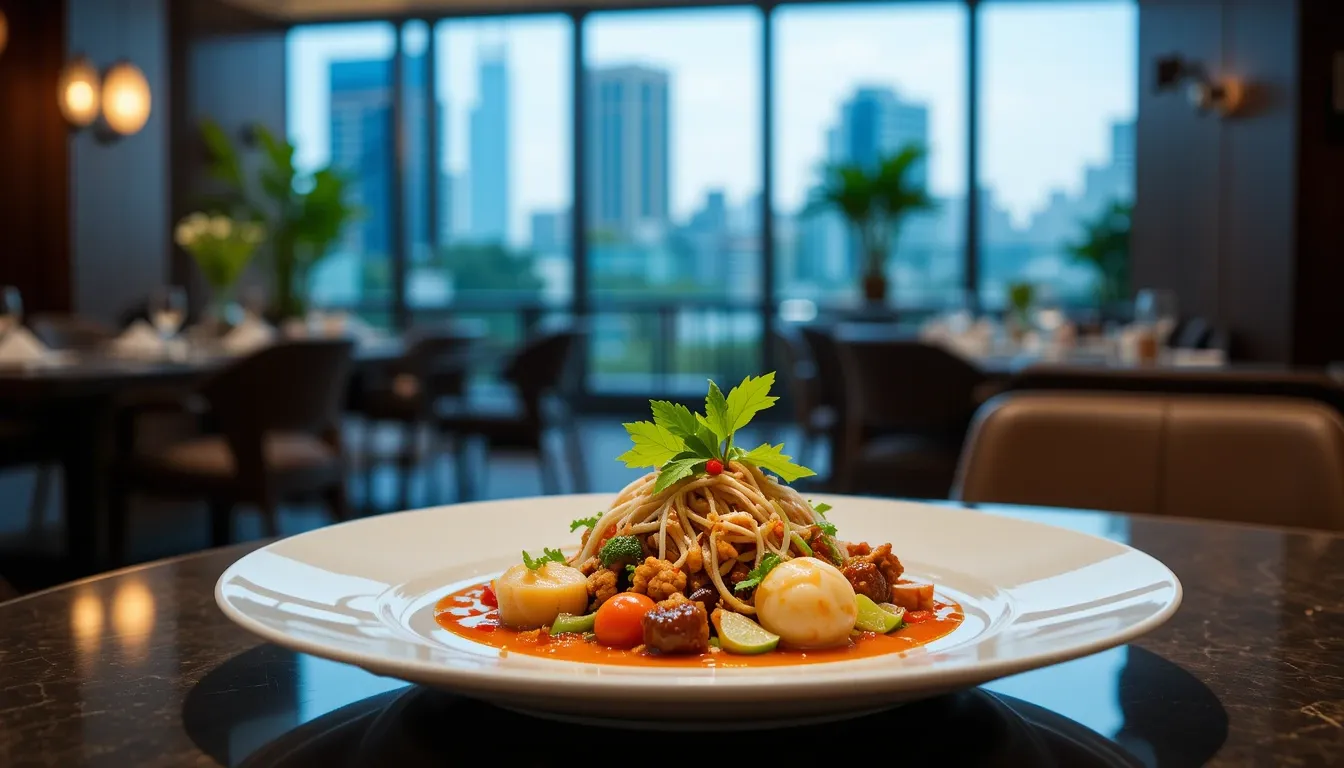
“Artfully presented contemporary Thai cuisine at a Michelin-starred Bangkok restaurant, showcasing the city’s elevated dining scene”
Sorn
- Concept: Authentic Southern Thai cuisine with sophisticated presentations
- Signature Dish: Khua kling (dry meat curry)
- Chef Profile: Chefs Ice and Yod research forgotten Southern recipes
- Price Range: (3,200+ baht tasting menu)
International Culinary Stars in Bangkok
Bangkok has attracted world-class chefs creating exceptional dining experiences beyond Thai cuisine.
Sühring
- Concept: Contemporary German cuisine with Asian influences
- Signature Dish: Spätzle “Münchner Art”
- Chef Profile: Twin brothers Thomas and Mathias Sühring reinvent German classics
- Price Range: (4,900+ baht tasting menu)
Gaggan Anand
- Concept: Progressive Indian cuisine with molecular techniques
- Signature Dish: Yogurt explosion
- Chef Profile: Chef Gaggan’s theatrical presentation and boundary-pushing flavors
- Price Range: (5,000+ baht tasting menu)
Restaurant Potong
- Concept: Progressive Thai-Chinese cuisine
- Signature Dish: Tom yum lobster
- Chef Profile: Chef Pam transforms her family’s century-old recipes
- Price Range: (4,500+ baht tasting menu)
For more affordable fine dining options, see our guide to Bangkok’s Best Value Tasting Menus.
Bangkok’s Extraordinary Dining Settings
The Bangkok fine dining experience extends beyond food to encompass spectacular settings and service concepts.
Riverside Elegance
- Le Normandie by Alain Roux: French perfection overlooking the Chao Phraya
- Sala Rim Naam: Royal Thai cuisine in a traditional pavilion
- Sirocco: Al fresco Mediterranean dining on the 63rd floor
Historic Venues
- Err: Rustic Thai dishes in a preserved shophouse
- Nusara: Intimate chef’s table in a century-old building
- The House on Sathorn: Ottoman mansion transformed into culinary destination
Innovative Concepts
- Haoma: Zero-waste philosophy with on-site urban farm
- Bo.lan: Carbon-neutral Thai fine dining
- Front Room: Nordic techniques applied to Thai ingredients
Navigating Bangkok’s Reservation Systems
Securing tables at Bangkok’s top restaurants requires planning and understanding local reservation practices.
Reservation Timelines:
- World’s 50 Best restaurants: 1-3 months in advance
- Michelin-starred venues: 2-4 weeks ahead
- Popular hotel restaurants: 1-2 weeks notice
Reservation Tips:
- Many top venues use online reservation systems like Tock or Chope
- Some restaurants require credit card guarantees
- For difficult reservations, hotel concierges often have special access
- Lunch reservations are typically easier to secure than dinner
Dress Codes and Etiquette:
- Business casual is minimum at most fine dining venues
- Many prohibit shorts, sandals, and sleeveless attire for men
- Photography policies vary widely between establishments
For assistance with securing difficult reservations, check out our Bangkok Fine Dining Concierge Services Guide.
Scandinavian Food Culture Guide: Nordic Cuisine Beyond the Stereotypes
Scandinavian cuisine has undergone a remarkable renaissance, moving far beyond stereotypical meatballs and smörgåsbord to celebrate indigenous ingredients and ancient techniques with modern sensibilities.
The New Nordic Cuisine Movement
This revolutionary culinary philosophy has transformed Scandinavian food culture and influenced global dining trends.
Core Principles:
- Emphasis on seasonality and locality
- Rediscovery of traditional preservation methods
- Modern interpretations of historic recipes
- Ethical and sustainable sourcing practices
Pioneering Restaurants:
- Noma (Copenhagen): René Redzepi’s revolutionary approach to Nordic ingredients
- Fäviken (Sweden): Magnus Nilsson’s remote restaurant showcasing hyperlocal cuisine
- Frantzén (Stockholm): Björn Frantzén’s precision and artistry with Swedish ingredients

“Contemporary Scandinavian dish showcasing foraged ingredients and preservation techniques that define New Nordic cuisine”
Impact on Home Cooking:
- Renewed interest in traditional preservation methods
- Increased foraging for wild ingredients
- Focus on reducing food waste through creative usage
Essential Scandinavian Ingredients and Techniques
Understanding key components and methods helps appreciate the depth of Nordic cuisine.
Foundational Ingredients:
- Dairy: Skyr (Icelandic yogurt), brunost (brown cheese), cultured butter
- Seafood: Herring, cod, salmon, langoustines
- Game: Reindeer, elk, grouse
- Plants: Lingonberries, cloudberries, sea buckthorn, spruce tips
Preservation Methods:
- Fermentation: Surströmming (fermented herring), rakfisk (fermented fish)
- Smoking: Cold-smoked salmon, hot-smoked mackerel
- Drying: Stockfish, flatbread, mushrooms
- Pickling: Cucumber, beetroot, herring
Regional Techniques:
- Sweden: Gravlax (cured salmon with dill)
- Norway: Rakfisk (fermented trout)
- Denmark: Smørrebrød (open-faced sandwiches)
- Finland: Karjalanpiirakka (Karelian rice pies)
- Iceland: Þorramatur (traditional winter preserved foods)
Learn to incorporate Scandinavian techniques in your home cooking with our Nordic Preservation Methods Guide.
Food Traditions and Social Customs
Scandinavian food culture is deeply intertwined with social rituals and seasonal celebrations.
Fika Culture:
- Daily coffee and cake ritual in Sweden
- Social institution beyond mere coffee break
- Traditional pastries like kanelbullar (cinnamon buns) and kladdkaka (sticky chocolate cake)
Seasonal Celebrations:
- Midsummer: Herring, new potatoes, strawberries
- Christmas: Julbord with ham, herring, and specific regional dishes
- Crayfish Parties: August tradition of eating crayfish with aquavit
- Waffle Day: Swedish tradition on March 25th
Drinking Traditions:
- Aquavit served with traditional meals
- Snapsvisor (drinking songs) during celebrations
- Toast customs varying by country
Contemporary Scandinavian Food Halls and Markets
Experience living food culture at these vibrant destinations across the region.
Denmark:
- Torvehallerne (Copenhagen): Upscale food market with local producers
- Aarhus Central Food Market: Contemporary take on traditional market
Sweden:
- Östermalms Saluhall (Stockholm): Historic market hall with modern offerings
- Malmö Saluhall: Industrial building converted to food destination
Norway:
- Mathallen Oslo: Converted factory housing specialty food vendors
- Bergen Fish Market: Historic seafood market with tasting opportunities
Finland:
- Old Market Hall (Helsinki): Waterfront market showcasing Finnish specialties
- Turku Market Hall: Finland’s oldest market hall dating from 1896
For the best food souvenirs from Scandinavia, read our Nordic Food Gifts Guide.
Global Culinary Guides: Planning Your Next Food Adventure
Food tourism has become a primary motivation for travelers seeking authentic cultural experiences. This section provides resources and strategies for planning exceptional culinary journeys worldwide.
Identifying Rising Culinary Destinations
Look beyond established food capitals to these emerging destinations offering distinctive culinary experiences.
Georgia (Country):
- Wine culture dating back 8,000 years
- Distinctive breads and dumplings
- Unique fermentation traditions
- Polyphonic toasting rituals
Malaysia:
- Multicultural fusion of Malay, Chinese, Indian influences
- Vibrant street food scenes in Penang and Kuala Lumpur
- Traditional nyonya cuisine
- Abundant tropical fruit varieties
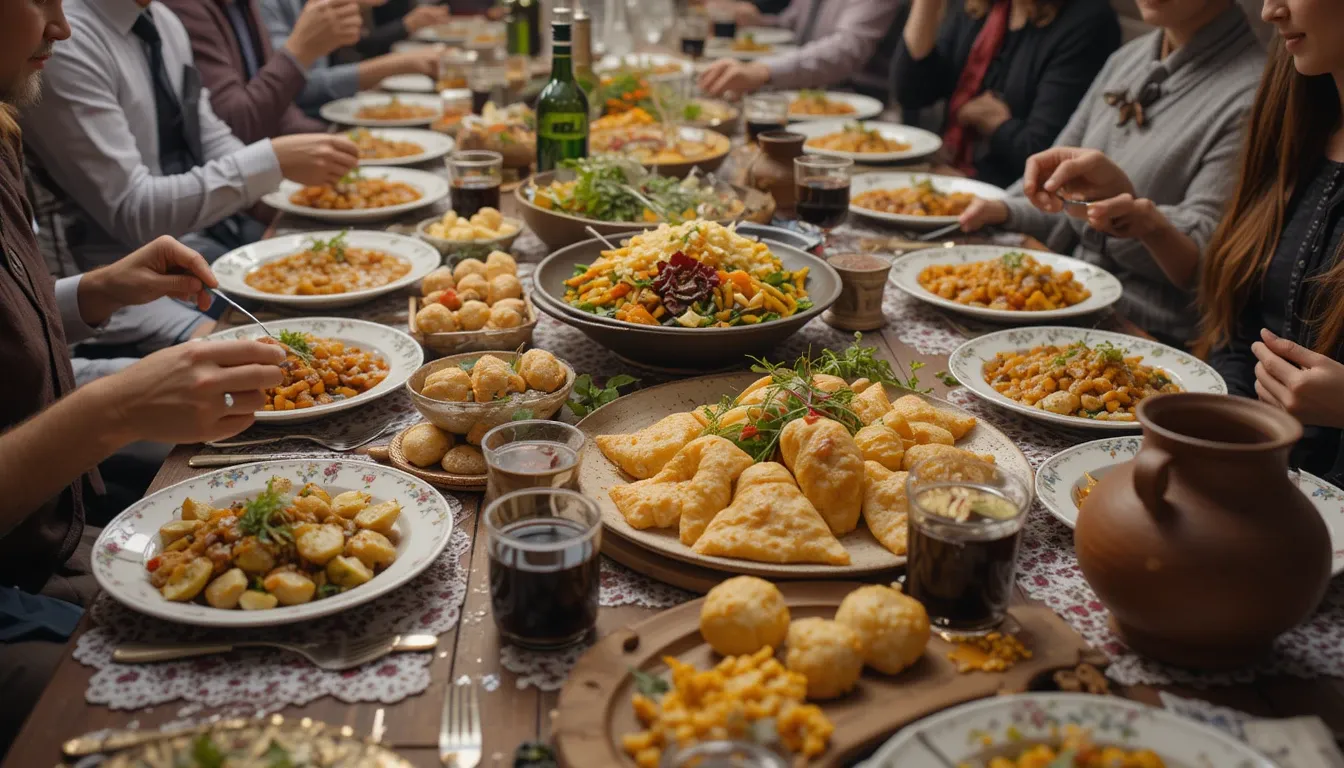
“Traditional Georgian supra feast featuring distinctive dishes like khachapuri and khinkali dumplings with local wine served in clay vessels”
Oaxaca (Mexico):
- UNESCO-recognized regional Mexican cuisine
- Seven distinctive mole sauces
- Ancient corn varieties and preparation methods
- Mezcal production traditions
Slovenia:
- Europe’s underrated culinary gem
- Influence of Alpine, Mediterranean, and Balkan cuisines
- World-class wine regions
- Farm-to-table ethos and beekeeping traditions
For profiles of chefs leading culinary innovations in these regions, see our Rising Culinary Stars Guide.
Food Festival Calendar: Global Culinary Events
Time your travels to coincide with these exceptional food festivals celebrating local traditions.
January-March:
- Madrid Fusión (Spain): Cutting-edge gastronomy conference
- Chiang Mai Flower Festival (Thailand): Featuring northern Thai cuisine
- Melbourne Food & Wine Festival (Australia): Showcasing Australian produce
April-June:
- Taste of Amsterdam (Netherlands): Highlighting Dutch and international cuisine
- Bordeaux Wine Festival (France): World’s largest wine tourism event
- Mistura (Peru): Latin America’s largest food festival
July-September:
- Pizzafest (Naples, Italy): Celebration of authentic Neapolitan pizza
- Maine Lobster Festival (USA): New England seafood tradition
- Copenhagen Cooking (Denmark): Showcase of New Nordic cuisine
October-December:
- Alba White Truffle Fair (Italy): Celebrating the world’s most precious fungus
- Kona Coffee Cultural Festival (Hawaii): America’s oldest food festival
- Diwali Food Festival (India): Sweets and specialties of the Festival of Lights
Culinary Travel Planning Resources
Essential tools and services for creating exceptional food-focused journeys.
Specialized Tour Operators:
- Culinary Backstreets for in-depth neighborhood food experiences
- Traveling Spoon for home-cooking experiences with local families
- Context Travel for scholarly food history explorations
Digital Resources:
- Eat Your World for regional specialties guides
- Culinary Anthropologist blog for cultural food contexts
- The World Food Atlas for visual guides to authentic dishes
Practical Considerations:
- Dietary restriction translation cards
- Local food safety guidelines
- Reservation assistance services
- Market tour etiquette
For recommendations on food photography equipment and techniques, visit our guide to Culinary Travel Photography.
Conclusion:
Cultivating Meaningful Connections Through Global Cuisine
Throughout human history, shared meals have fostered understanding across cultural boundaries. Today’s culinary travelers have unprecedented opportunities to experience authentic global traditions from Peru’s ancient ingredients to Bangkok’s innovative fine dining, Norway’s sustainable practices, Spain’s regional diversity, and Scandinavia’s preservation techniques.
True culinary travel transcends mere consumption to embrace deeper cultural understanding. Whether you’re sampling ceviche in Lima, sustainable seafood in Oslo fjords, pintxos in San Sebastián, elevated Thai cuisine in Bangkok, or foraged ingredients in Copenhagen, each meal tells a story of people, place, and tradition.
The most memorable travel experiences often center around the table, where strangers become friends, traditions are shared, and understanding grows one delicious bite at a time. May your global culinary journeys nourish both body and spirit while creating connections that transcend borders.